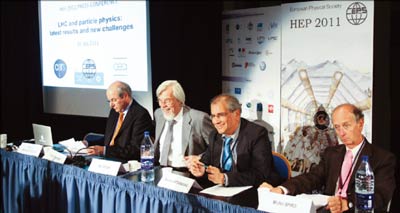
Image credit: LPSC/Tomas Jezo.
Impressive results, and so much more to come: this is the general feeling that more than 800 participants took home from the International Europhysics Conference on High-Energy Physics, EPS-HEP 2011, which was held in Grenoble on 21–27 July. After only a year of data-taking, the spectacular performance of the LHC and the amazingly fast data analysis by the experiments have raised current knowledge by a huge notch in searches for new physics.
Those who had hoped that the LHC would reveal supersymmetry early on may have been slightly disappointed, although each extended limit contributes to the correct picture and new physics is guaranteed, as many speakers reminded the audience. CERN’s director-general, Rolf Heuer reinforced this point, stating that for the Higgs boson in particular, either finding it or excluding it will be a great discovery.
On the search for the Higgs boson, both the CMS and ATLAS experiments at the LHC have observed small excesses of events in the WW and ZZ channels. Each one is statistically weak but taken together, they become interesting, as each team independently sees a small excess in the low range for the Higgs mass. While this is exactly how a Standard Model Higgs would manifest itself, it is still far too early to tell (The LHC homes in on the Higgs).
Another big topic of conversation was the report by the CDF collaboration at Fermilab of the first measurement of the rare decay Bs→μμ, appearing possibly stronger than predicted. On the other hand, the CMS and LHCb collaborations at the LHC showed preliminary results, which when combined provide a limit in contradiction with the CDF result (CMS and LHCb pull together in search for rare decay). More data will soon clarify what is happening here.
The session on QCD showed great progress in the field, with updates on parton-distribution functions from the experiments at HERA, DESY, as well as several results from the LHC experiments. These measurements are now challenging the precision of theoretical predictions, and will contribute towards refining the Monte Carlo simulations further. The experiments at Fermilab’s Tevatron and at the B-factories also presented improved and impressive limits in all directions in flavour physics, contributing to a clearer theoretical picture.
In neutrino physics, new results came from the T2K and MINOS experiments, giving the first indications of a sizeable mixing angle between the first and third neutrino generations (MINOS and T2K glimpse electron neutrinos). It was particularly moving to see how Japanese colleagues are recovering after the devastating earthquake and tsunami. Atsuko Suzuki, head of the KEK laboratory, thanked the particle-physics community for its extended support.
An important highlight of the conference was the award of the European Physical Society (EPS) High Energy and Particle Physics Prize to Sheldon Lee Glashow, John Iliopoulos and Luciano Maiani. They received this for their crucial contribution to the theory of flavour, currently embedded in the Standard Model of strong and electroweak interactions, which is still of utmost importance today.
With the first results from significant amounts of data at the LHC, the conference attracted a great deal of interest from the world’s press. A press conference was held on 25 July to announce the EPS 2011 high-energy physics prizes, with contributions on the latest results from the LHC, the European strategy for particle physics, and the latest advances in astroparticle physics in Europe.
• A more detailed report will appear in the October issue of the CERN Courier.








